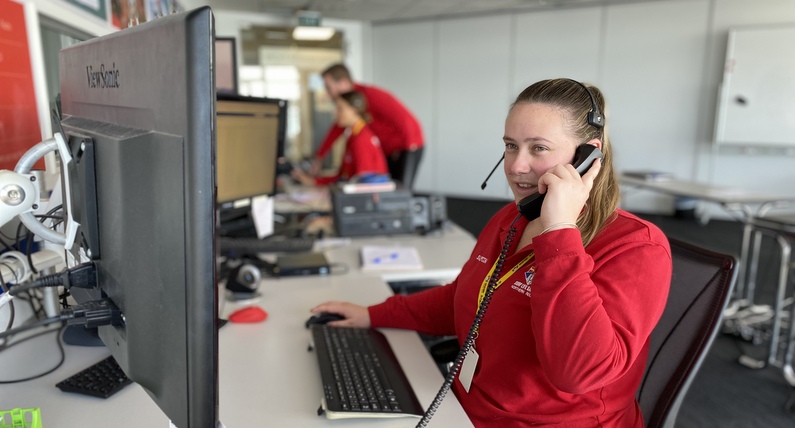
The evolution of SurfCom
From monitoring early regional radio networks to real-time national coordination, the Surf Life Saving Communications Centre (SurfCom) has come a long way.
The first regional radio networks for surf life saving clubs were set up around 1995, as the demand for lifeguarding services rose sharply in Auckland and Canterbury.
SurfCom was established at the Auckland Marine Rescue Centre soon after, supporting clubs in the Northern Region. Radio network infrastructure grew in stages, as funding and resources allowed. The 2022/2023 season saw a historic milestone: SurfCom was finally able to extend its support to all surf lifesaving oper-ations, including 40 SAR squads and 74 surf life saving clubs operating across 92 patrol locations.
In peak season, a shift of four SurfCom Operators plus a Duty Officer provide monitoring and support, as well as initiating SAR operations. “Being co-located with the Police Maritime Unit and Coastguard Operations Centre is fantastic for multi-agency SAR operations,” says Laura Beanland-Stephens, SurfCom Manager.
As well as providing nation-wide coordination and support, the Duty Officer can provide advice on policy and procedure. “Being aware of every operation across the country means we can ensure our member wellbeing follow ups are initiated. Likewise our media team knows what is going on, so they can issue timely press releases as well as tell our stories to help celebrate all the work our people do.”
Nearly 30 years of infrastructure development has meant net-works were established using the technology of the day. Now there are nine different radio networks across the country. “It's been a significant challenge to integrate these disparate networks into onecentralised system,” says Laura. “Getting the appropriate funding and support to realise that capability was a major milestone for us as an organisation. But we see it as just the start of what we will be able to do in the future.”
The evolution of SurfCom mirrors that of the surf lifesaving movement as a whole. “We’re constantly developing to deliver the best support to our communities that we can.”
Not all of the areas are connected with SurfCom via radio net-work yet. The central North Island coastal areas are due to come online in 2024. However, all services can reach SurfCom via phone as well as the Surf Patrol App. “The app was built and originally used by Surf Life Saving Northern Region. Last summer was the first time it was operating nationwide,” says Laura.
“The Surf Patrol App provides incredible situational awareness for the organisation, allowing us to capture data, anticipate needs and support our people far more effectively than ever before. For our clubs, it significantly reduces the administrative load.” SurfCom can see which surf lifeguards are on patrol plus their qualifications. Reported daily hazards are displayed as well as beachgoer numbers, incidents, preventative actions and so on. When surf lifeguards log on to the Surf Patrol App, the public-facing Safeswim.org.nz site updates to show that the beach is patrolled, along with any relevant safety warnings. Further integrations in the SAR space, such as group callout and reporting functions are in development.
Feature image: SurfCom is staffed and available 24/7. SAR coordinating authorities and partner agencies can call SurfCom directly to activate a response from Surf Life Saving New Zealand. Representatives should contact surfcom@surflifesaving.org.nz for the direct phone number. Members of the public who require urgent help should still dial 111 and ask for Police.
This story was originally published in the April 2024 issue of Link magazine.
